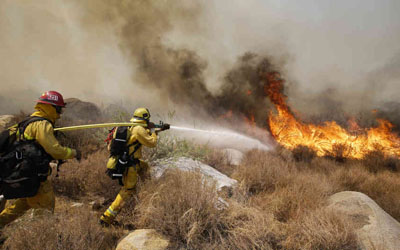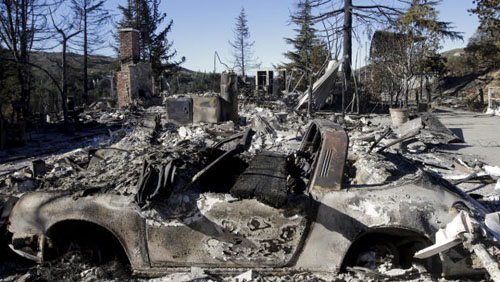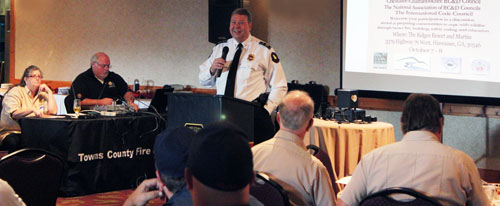
 |
| Successful Community-Based Workshops Nearing Completion Two trends involving fire damages are at work in the United States these days: first, the rate of all fires in the nation is on the decline, but the number of wildfires and wildland-urban interface (WUI) fires is rising steadily, a startling fact to many property owners and community leaders throughout the nation; the second is what a nearly-completed series of workshops involving local conservation and development volunteers with national fire and building code officials has been trying to resolve.  First, here are some provocative statistics: First, here are some provocative statistics:• Since 1960, there has been a 380 percent increase in the number of Americans living wildland-interface areas of the United States. • Since 1960, there has been a 1,300 percent increase in the number of homes burned in WUI areas. • Annually, about 100,000 fires burn over 7 million acres (2,832,799 ha). But a rarely discussed fact is that 97,000 of these fires are extinguished after burning less than 10 acres (4.5 ha). • The remaining 3,000 fires (or three percent of the annual average) account for the lion’s share of today’s wildfire acreage. This three percent of the total wildfires in the United States is where the majority of civilian and firefighter fatalities occur. It is where the largest percentage of home losses takes place with the highest insurance claims. It also is where skyrocketing costs are found that sharply impact federal and state budgets. As a result of this escalating crisis, an innovative Code Council joint initiative called “Wildfire Safe, Sound and Code Smart,” began in the fall of 2012, funded by a Department of Homeland Security-U.S. Fire Administration Fire Prevention and Safety Grant. The primary partnership has been with the National Association of Resource Conservation &Development Councils (RC&D) through a FEMA Fire Prevention Grant. ICC worked with National Institute of Standards and Technology (NIST) through a special NIST WUI grant. The grant’s objective was to work in 18 states to conduct workshops, starting in 2013 and wrapping up by spring of 2014. The NARC&D and ICC, along with other groups, developed the national program which provided a multi-faceted approach to WUI mitigation on a grassroots level. The program guides and supports community leaders as they develop and adopt the IWUI code, while actively encouraging implementation of existing WUI educational programs. By teaming the NARC&DC’s local networks and resources along with other key fire, research, insurance interests and the ICC’s code adoption and enforcement expertise, the grassroots networks have been working together to increase IWUI code adoption and public awareness in targeted communities throughout the United States. "Public education and awareness programs like ’Firesafe, Firesmart, Firewise, Firefree, Fireready’ and ‘Ready, Set, Go’ each play a vital role in reducing the risk of WUI fires by educating communities where potential hazards exist, and steps to minimize them," said Dan Bailey, Program Coordinator for the Code Council. “Adoption and enforcement of the IWUI code also plays a critical role in WUI fire mitigation, strategically complementing existing WUI fire prevention programs. "The focus of the WSS&CS program is at the community level, working with communities’ leaders and highlighting the importance of the ICC’s IWUI Code in wildfire community planning and prevention."  Bailey said that tallying up the numbers that each state has designated as high wildfire risk communities is staggering. "The statistics show that 72,000 at-risk communities are located in 220 million acres (89,030,841 ha), which is an area that is twice the size of California," he explained. "Within these high-risk communities are 46 million homes and 120 million people that call this wildland-urban interface home. Bailey said that tallying up the numbers that each state has designated as high wildfire risk communities is staggering. "The statistics show that 72,000 at-risk communities are located in 220 million acres (89,030,841 ha), which is an area that is twice the size of California," he explained. "Within these high-risk communities are 46 million homes and 120 million people that call this wildland-urban interface home."Since 1990, according to the National Resource Conservation Service, the U.S. has experienced an unprecedented growth rate of 3 acres per minute," he continued. "That translates to 4,000 acres per day and close to 2 million acres per year of conversions from wildlands to wildland-urban interface." Headwaters Economics, a non-profit think tank in Bozeman, Mont., recently refined these numbers even more with research highlighting the fact that within the 11 western states, 14 percent of the available WUI areas that are available to build in have been already developed. The report says 86 percent remains available for development, highlighting the fact that America’s wildfire control problem is just beginning. In addition to experiencing larger, more deadly fires, ballooning costs and more homes destroyed, recent government budget cuts and reductions at federal, state and local levels are compounding the problem of control and mitigation. Other factors become greater concerns, including fuels mitigation dollars drying up, grants to help local communities disappearing and a subtle change which finds federal agencies ramping up efforts to shift more WUI responsibility from federal oversight to state and local officials. "As we look at the numbers it is clear that we have an escalating problem that does not seem to be getting resolved any time soon. The ‘perfect storm’ scenario is developing as we see more people moving to these fire prone areas," Bailey said. "The Wildfire Safe, Sound and Code Smart effort has been a very effective tool in getting the message to homeowners, communities and cities throughout the nation. The task is getting that message in front a growing group of citizens, officials and leaders." Mel Cosgrove, Code Council Government Relations Senior Regional Manager, participated as a trainer in a number of the ICC and RC&D workshops. He said the workshops reached to people, businesses and organizations that have not been directly involved in code planning and implementation before. "I cannot begin to tell you how valuable these workshops have been to the ICC," Cosgrove said. "I have had elected officials, home builders, real estate brokers, fire officials, building officials, insurance executives, home owners, RC&D council members as well as others in these workshops. The workshops include a detailed module on the ICC and we have been able to spread the word about the importance of codes and the ICC to a large group that we might not have been able to reach before. "When you have a rural county commissioner come up to you at the conclusion of the workshop and tell you how much he enjoyed the workshop and how much he learned about the value to codes, it makes it all worthwhile. In my opinion, even if no one ever adopted the IWUI code, the education and citizen involvement had made it all worthwhile."  Cosgrove said the local meetings produced positive results that will reap local dividends for years. Dwayne Garriss (pictured right), Georgia State Fire Marshal, attended the workshop in Hiwassee, Ga., in October and made the official announcement that Georgia will adopt the 2012 IWUI effective Jan. 1, 2014. “I have been contacted by other jurisdictions that are also very much interested in the code as well,” he said. Cosgrove said the local meetings produced positive results that will reap local dividends for years. Dwayne Garriss (pictured right), Georgia State Fire Marshal, attended the workshop in Hiwassee, Ga., in October and made the official announcement that Georgia will adopt the 2012 IWUI effective Jan. 1, 2014. “I have been contacted by other jurisdictions that are also very much interested in the code as well,” he said.As the national crisis of more and deadly wildfires continues, programs like Wildfire Safe, Sound and Code Smart help educate communities about the importance of codes and working together to protect lives and properties by stressing the goal of increased WUI fire safety through the adoption of the IWUI code. Local RC&D Councils and ICC representatives educate participants about WUI code, compliance and enforcement. They also provide teams with the training and resources to effectively address concerns from individual citizens and to better educate the public about ways to prevent wildfires in and around their homes and businesses, using the existing WUI preventative programs. For more information on the WSS&CS Program, contact the ICC Government Relations representative in your state or email Dan Bailey. |
||